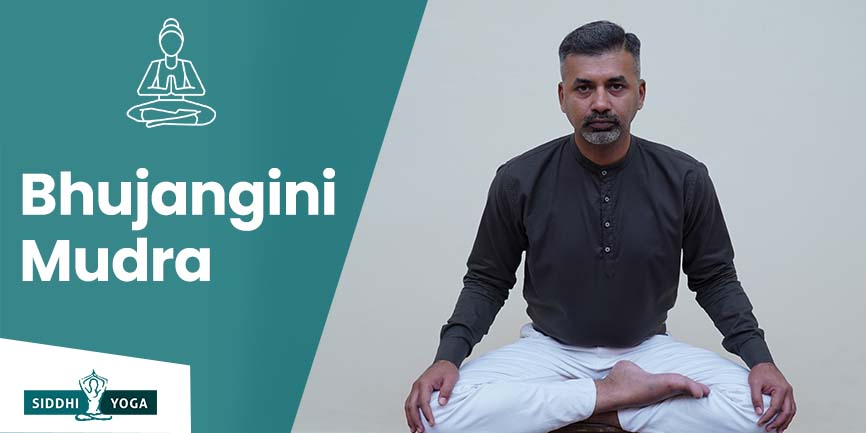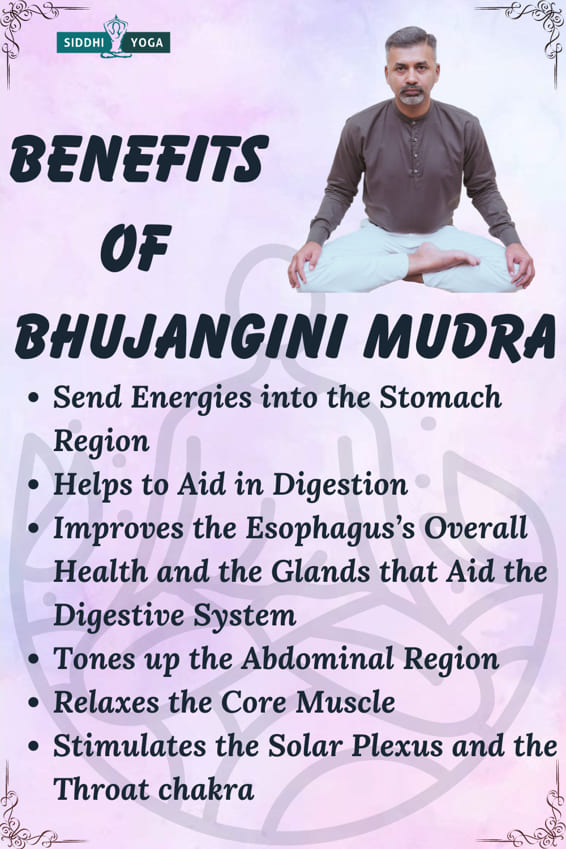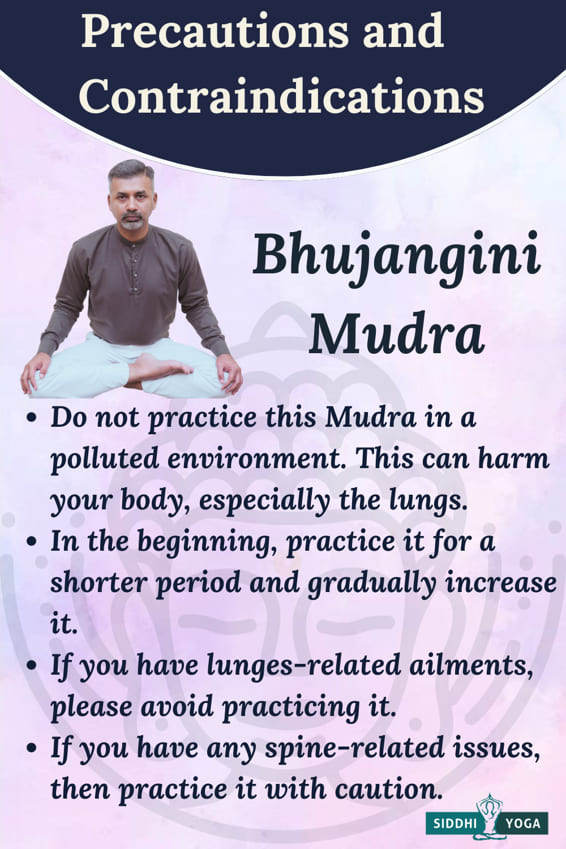
Find out the meaning and benefits and how to perform Bhujangini Mudra. And explore how it can help you achieve a healthier lifestyle.
Definition – What is Bhujangini Mudra and its Meaning, References, and Mythology?
Bhujangini Mudra is a type of Mudras or gesture/seal. Bhujangini Mudra is one of the Mudras which has more emphasis on Breathing. To understand this Mudra better, let us break Bhujangini Mudra into two parts:
Bhujangini – The Sanskrit word “Bhujangini” represents a serpent or Cobra.
Mudra – “Mudra” as we all know, means a gesture or seal.
So, this Mudra is also known as the Serpent or Cobra gesture. This Mudra is related to breathing technique or respiration, so sometimes it is also known as Serpent Respiration. It was named after our body’s posture, which resembles a Cobra with its hood flared.
It is believed that if someone practices this Mudra, it can improve digestion and hunger. It strengthens our inner abdominal walls. This Mudra calms not only the physical hunger but also the mental and spiritual ones. Our body sometimes needs mental and spiritual food, but we seldom realize it.
This Mudra is one of the Mudras that have benefits similar to a Pranayama practice, so this Mudra practice brings benefits that are similar to Pranayamas. This Mudra is also believed to help awaken the Kundalini Shakti.
Bhujangini Mudra is generally practiced while assuming a sitting posture. However, this Mudra can also be practiced while taking the Cobra pose or Bhujangasana. This posture is also believed to strengthen the esophagus walls and improve the digestive process of secretion. This Mudra practice also aids in the process of Peristalsis. Peristalsis is a process where several contractions happen in the food pipe that transports the food inside the esophagus toward the stomach.
Alternate Names of Bhujangini Mudra
Serpent gesture or Cobra gesture.
How to Do Bhujangini Mudra?
- This is one of the Mana Mudras or the Head gestures. This Mudra is often practiced while assuming a seated Meditative pose. However, this Mudra can also be practiced while assuming the Cobra Pose or Bhujangasana.
- We can start by sitting in any meditative posture, such as Siddhasana (Accomplish Pose) or Sukhasana (also known as Easy Pose)1.
- Rest both of your hands comfortably on your knee. Palms facing downward towards the ground, or you can keep a slight grip on your knee.
- Gently close your eyes and take a deep breath in. Relax your entire body, especially the abdominal region.
- Now, slowly and gently bend your upper body slightly forward. And protrude your chin forward and then up a little.
- Then with your mouth, suck the air inside and try to draw the air toward the stomach region. Gulp more and more breath inside as if you are drinking the water while ensuring that you bring the air towards the abdomen, not the lungs.
- Let your stomach come out as much as possible when you suck the breath inside.
- Hold your breath inside as long as possible.
- Then exhale slowly. (While many texts advocate bleching/burping while exhaling in this Mudra but this could be difficult for various practitioners.)
- Completely close your eyes.
- Practicing it 3-5 times a day is sufficient.
Bhujangini Mudra Benefits

- This Mudra is always known for its Digestive properties. It improves the digestive system as we fill maximum breath inside this body, pushing the diaphragm towards the abdominal cavity and stimulating digestive organs.
- This Mudra is believed to send energies into the stomach region, which also aids the organs located inside the stomach region. So, this is believed to end not only physical hunger but also mental and spiritual ones.
- This Mudra improves the esophagus’s overall health and the glands that aid the digestive system.
- This Mudra practice tones up the abdominal region as well.
- We all know that core muscles are very important to muscle groups in our bodies. When we practice this Mudra, this helps to rejuvenate them as well. It relaxes the core muscles.
- This is also believed that if a practitioner retains enough air inside his body, he can float over the water.
- It also stimulates the Solar plexus (Manipur Chakra) and The Throat chakra (Visshuddhi Chakra).
Bhujangini Mudra Precautions and Contraindications

- Do not practice this Mudra in a polluted environment. This can harm your body, especially the lungs.
- In the beginning, practice it for a shorter period and gradually increase it.
- If you have lunges-related ailments, please avoid practicing it.
- If you have any spine-related issues, then practice it with caution.
When and how long to do Bhujangini Mudra?
- If you want to improve your digestive system, then it will help.
- If you want to stimulate your Manipur Chakra and Vishuddhi Chakra (throat Chakra), practicing this will help.
- This will help tone up the abdominal muscles, so if you want to tone your abdominal region, try practicing it.
Morning is the ideal time to do any yoga or Mudra. Our brain is at its best in the morning and during the daytime. So, you are more likely to be able to concentrate easily. Therefore, you should practice this Mudra from 4 am and 6 am to get the most effective outcomes.
If you are having difficulty with this during the morning, you can do this Mudra later in the evening too.
Practicing this Mudra for a minimum of 2-5 times daily is recommended. Whether you wish to complete it in one stretch or two threes that last between 5 and 10 minutes, it’s up to you. Based on research, the best way to practice an exercise for at least 20 minutes is to get the best benefits of that particular Mudra.
Breathing in Bhujangini Mudra
To enhance your practice, you can practice breathing techniques with this Mudra.
- This Mudra is considered Pranayama, so practicing this can give you benefits similar to a Pranayama practice.
Affirmation in Bhujangini Mudra
You can keep an intention of the practice:
“I am quiet. I am peaceful, and I have a world within me.”
Conclusion
The Bhujangini Mudra is an excellent tool for anyone seeking to improve their yogic practice. This Mudra can help increase energy and vitality by stimulating the navel chakra. Additionally, the Bhujangini Mudra can also help to improve digestion and elimination. Check out our Mudras certification course if you are interested in learning more about mudras and how to incorporate them into your yoga practice. This course will cover all 108 mudras so you can learn how to use each one to maximize your yoga experience.